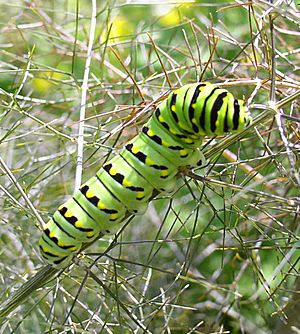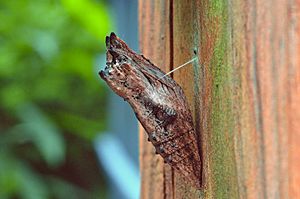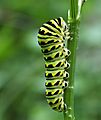Black swallowtail facts for kids
Quick facts for kids Black swallowtail |
|
|---|---|
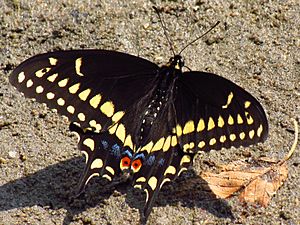 |
|
| Male | |
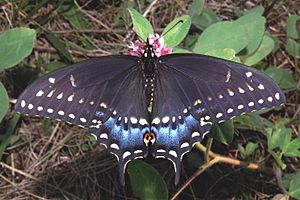 |
|
| Female | |
| Conservation status | |
| Scientific classification | |
| Genus: |
Papilio
|
| Species: |
polyxenes
|
| Subspecies | |
|
|
The black swallowtail (scientific name: Papilio polyxenes) is a beautiful butterfly. It is also known as the eastern black swallowtail, American swallowtail, or parsnip swallowtail. You can find it across a large part of North America. It is even the official state butterfly of Oklahoma and New Jersey.
This butterfly gets its name from Polyxena, a character in Greek mythology. Its caterpillar is often called the parsley worm because it loves to eat parsley and similar plants.
Contents
About the Black Swallowtail
The black swallowtail is part of the swallowtail butterfly family. These butterflies often have "tails" on their hindwings, which look a bit like the tails of swallow birds. The black swallowtail belongs to the Papilio group, which is the largest group in the swallowtail family.
Where They Live
Black swallowtails live from southern Canada all the way down to South America. In North America, they are most common east of the Rocky Mountains. They like open spaces such as fields, parks, marshes, or deserts. They prefer warm or mild climates.
What They Look Like
Black swallowtail butterflies go through several stages of life.
Eggs and Young Caterpillars
The eggs of the black swallowtail are pale yellow. When they first hatch, the young caterpillars are mostly black and white. They have a white "saddle" mark on their back. As they grow older, they turn green with black stripes and yellow spots.
Caterpillar and Chrysalis
Black swallowtail caterpillars eat plants that contain toxins. These toxins make the caterpillars taste bad to birds, which helps protect them from being eaten.
When a black swallowtail caterpillar feels threatened, it has a special defense. It can stick out an orange, forked gland called an osmeterium. This gland looks a bit like a snake's tongue and releases a foul smell to scare away predators.
The pupae (also called a chrysalis) can be green or brown. Their color helps them blend in with their surroundings. A green chrysalis might turn a darker green just before the butterfly emerges. This color change happens a few hours to a day before hatching.
Unlike some other butterflies, the black swallowtail chrysalis is held in place by a silk loop around its middle. Its "feet" are also attached to a silk pad. This setup helps the butterfly unfold its large wings easily when it comes out.
Clever Disguises: Mimicry
Female black swallowtails have markings that look very similar to another butterfly called the Pipevine Swallowtail. This is a type of mimicry. Birds usually avoid eating Pipevine Swallowtails because they taste bad. By looking like them, female black swallowtails are less likely to be eaten by birds.
Females show the top side of their wings more often when they are laying eggs. So, their top wing patterns have evolved to mimic the Pipevine Swallowtail. The underside of both male and female black swallowtail wings also looks like the Pipevine Swallowtail. This protects both males and females when they show their undersides.
Life Cycle of the Black Swallowtail
Female black swallowtails lay single eggs on host plants. They usually choose new leaves or sometimes flowers.
- The egg stage lasts about 4 to 9 days.
- The caterpillar (larval) stage lasts 10 to 30 days.
- The chrysalis (pupal) stage lasts about 18 days.
The exact time for each stage can change depending on the temperature and the type of plant the caterpillar eats.
Emerging as Adults
Black swallowtails spend the winter as a chrysalis. Adult butterflies emerge in the spring to find host plants. They usually emerge in the mornings.
There are often two main groups, or "broods," of adults each year:
- The first brood flies from mid-May to late June.
- The second brood flies from early July to late August.
- Sometimes, a smaller third brood might appear later in the season.
How Long They Live
Black swallowtails live longer than many other butterflies in temperate areas. They are fast and agile, which helps them escape predators. However, they are most at risk when they cannot fly, perhaps due to bad weather or lack of food.
What They Eat
Black swallowtail caterpillars eat various plants from the carrot family (Apiaceae). Female butterflies choose where to lay their eggs based on how the plants look and smell. The smell of a host plant is a key signal for them to decide where to lay eggs. Even if a caterpillar eats a certain plant, the adult butterfly doesn't necessarily prefer that plant later on.
Some common host plants include:
- Mock bishopweed (Ptilimnium capillaceum)
- Roughfruit scaleseed (Spermolepis divaricata)
- Spotted water hemlock (Cicuta maculata)
- Water cowbane (Oxypolis filiformis)
- Italian parsley
- Wedgeleaf eryngo (Eryngium cuneifolium)
- Canby's dropwort (Oxypolis canbyi)
- Queen Anne's lace (Daucus carota)
- Dill (Anthem graveolens)
Black Swallowtail Behavior
Staying Warm or Cool
Butterflies need their body temperature (especially in their chest, or thorax) to be around 24 degrees Celsius (75 degrees Fahrenheit) to fly. Black swallowtails have clever ways to control their body temperature:
- In cooler temperatures, they raise their abdomens (the back part of their body) above their flattened wings. They also perch closer to the ground.
- In warmer temperatures, they lower their abdomens into the shade of their wings. They also perch for shorter times, fly more, and perch higher up.
Defending Their Space
Male black swallowtails claim special areas to find mates. These areas don't necessarily have a lot of food or places to sleep. Once a male claims a spot, he usually keeps it to himself about 95% of the time. If another male comes near, he will chase them away and then return to his spot. Being good at defending a territory depends on how many other males are around and how successful he has been before. The size of the male doesn't seem to matter.
Males that emerge earlier in the season are more likely to get the best territories, which females prefer. These "best" territories are usually on higher ground or distinct spots. This makes it easier for females to find males, as the males gather in predictable locations.
Fighting for Territory
Males are very aggressive in defending their territories because having a good spot is key to finding a mate. There are usually more males than females, and females don't mate very often. This leads to a lot of competition between males.
Mating Habits
Males Emerge First
Black swallowtails are "protandrous," which means the males emerge from their chrysalises before the females do. This gives the early-emerging males a better chance to claim the best territories. Having a good territory greatly increases a male's chances of mating.
Females, on the other hand, benefit from emerging later. Their fertility is linked to their weight when they emerge. Emerging later allows them to feed longer as caterpillars and grow larger. While males don't need to be large to be successful, they emerge early to get those prime territories.
However, there's a downside for early males: male mating success tends to decrease as the mating season goes on. So, early males might not mate as often later in the season when most females are emerging.
Lek Mating System
The way black swallowtails claim territories leads to a special mating system called lek mating. This means: 1. Males don't help care for the young. 2. Males gather in specific spots to show off. 3. The only thing females find at these spots are the males themselves. 4. Females get to choose their mates from the males gathered there.
The territories where males have the most aggressive encounters are usually the most desired by both males and females. These spots also have the most female visitors. Hilltop leks, for example, make it easy for females to find mates. The competition among males at these spots also means that the males who successfully hold these territories have already proven their "quality" as a mate.
Similar Butterflies
Here are some other butterflies that look similar to the black swallowtail:
- Old World swallowtail (Papilio machaon)
- Indra swallowtail (Papilio indra)
- Short-tailed swallowtail (Papilio brevicauda)
- Anise swallowtail (Papilio zelicaon)
Gallery
Images for kids




